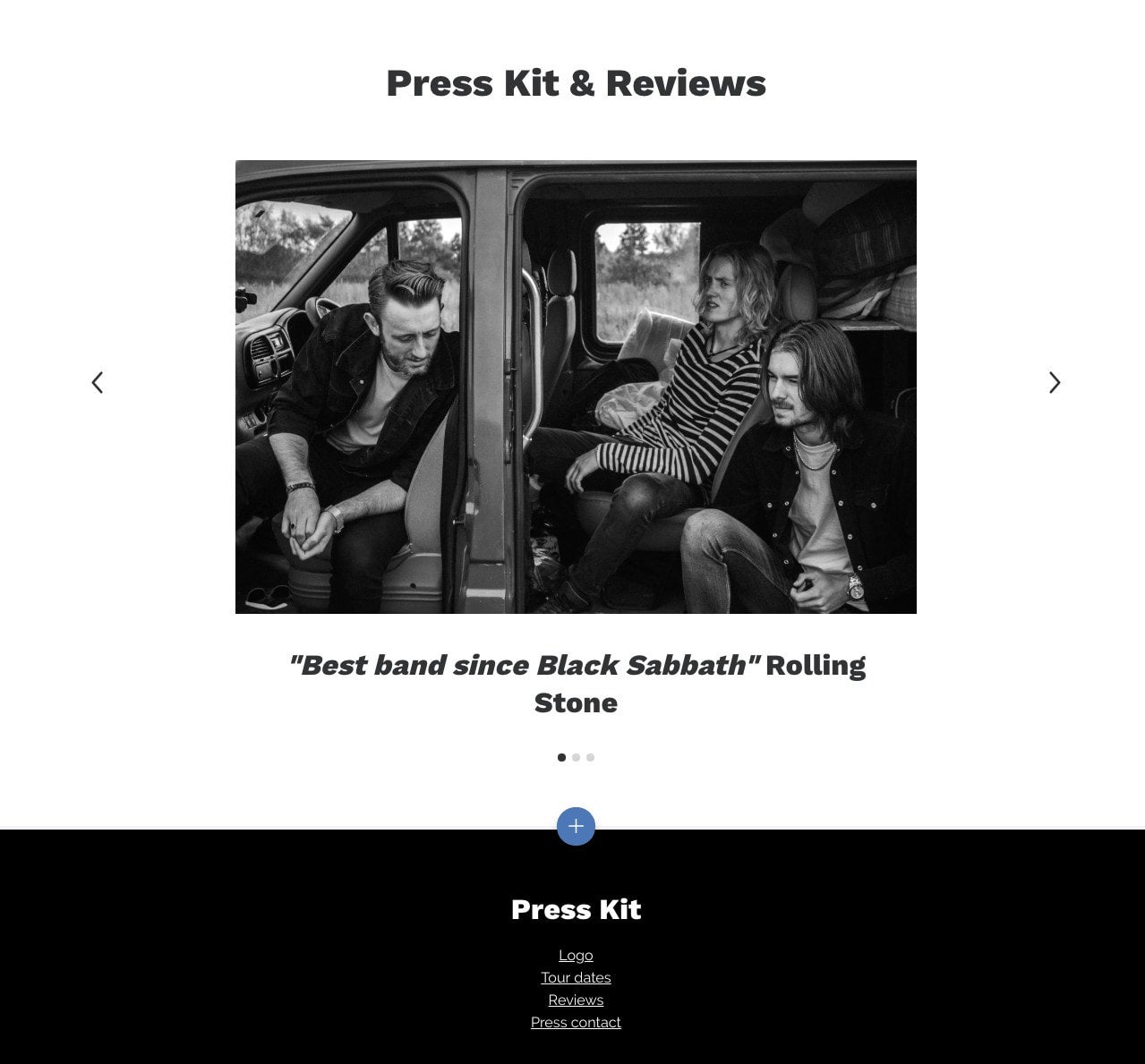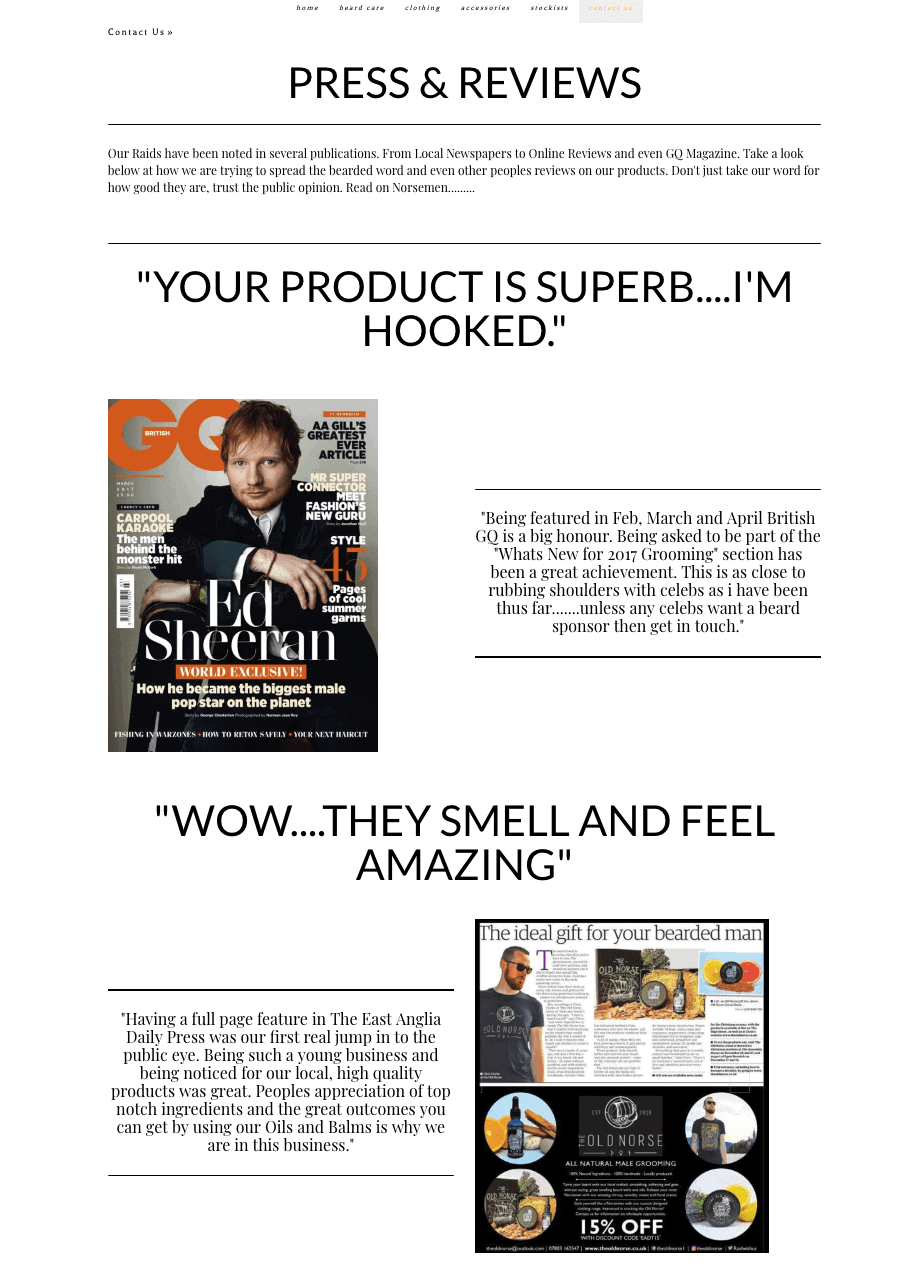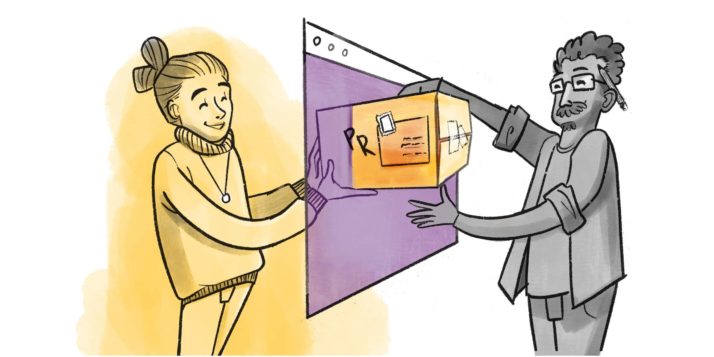Press coverage and online reviews are a great way to get free publicity for your business or band. Not only do they bring traffic to your website and gain you recognition, but being mentioned by established websites earns you trust points with prospective customers. So when journalists search for your business online and are on a tight deadline, it pays to have all your materials ready.
Having a press kit on your website shows journalists and visitors that you’re professional and makes it easy for reviewers and press to write about you.
Here’s what you need to know:
- What is a press kit?
- What is the goal of my press kit?
- What should my press kit include?
- How do I add a press kit to my website?
What is a press kit?
A press kit (or media kit) is a page on your website that contains all your promotional materials and resources for your business or band. A good press kit will give journalists quick and easily digestible info about your product or business as well as photos or any marketing materials they can use. Think of the highlights or main message you want to use to promote your business and include quotes or statistics to back this up.
A press kit isn’t just useful for the press, it’s also useful for possible investors, partners or bloggers and influencers. That’s why it’s always best to add important info that’s useful for everyone along with more specific info depending on your target market and goals.
What are the advantages of a press kit?
Your press kit is basically a business resume for journalists, publishers, and promoters. When you’re networking, you can always refer to your press kit and share it with journalists. So they have everything they need to write your story and they can always check back on it if they forget stats you mentioned in the meeting. The easier you make it, the more likely they’ll be to write about you!
Tip: If you attend a lot of conferences or events you can add your press kit to a USB stick and give them out. This way you can use it as a calling card with all the info about your business. Plus, you can distribute all the essential info they need in high-quality and bigger files.
What is the goal of my press kit?
Any media kit can be tailored to your specific marketing goals. How you format your content will change depending on whether you’re launching a product, promoting an event, or opening a new business. Once you have a goal in mind you can gather info and images to back it up.
Here are some examples of what you can do with your press kit:
Launch a new product
A media kit is perfect for sharing details about your new product or service. You can focus on describing the features, pricing, and how customers can reach you. It’s also a great way to promote the services or products you already offer.
Promote an event
Want to drum up excitement for a new campaign, gig or event? Then your press kit is a great way to share the details. Just pass it on to local journalists and news outlets in your community.
Opening a business
Have you just opened a new business or moved to another area? This is the perfect time to introduce yourself and your services to your new community and local press.
What should my press kit include?
There are some essentials that every press kit should include.
Logo, high-resolution images, media, and branding
The best way to encourage journalists to write about you is to provide all the materials they’ll need for a good article. A great online press kit includes downloadable logos, images, infographics, and even promotional videos.
It’s best to provide several high-resolution variations that also include different formats (e.g. .png and .jpg). Your logo should have a transparent background so your graphics can be used for multiple formats including print.
Tip: If you have any brand guidelines for how and where to use images or files, then make sure to link to these.
Design a logo that makes your business stand out.
Your company story
This is the chance to share your mission and the “why” behind your business. Typically, the business story should include a brief description of your company’s history, mission, and product or service. Make sure it sits up top and is tailored to the purpose of your press kit. This section can take inspiration from your About page but should be no longer than 100 words and give busy journalists a quick overview of what you do.
Important stats and facts about your company
Do you have numbers that back-up what you want to achieve with your press kit? Here’s the chance to show your growth and how your brand is making an impact in your industry. Think about memorable and relevant points like:
- Where is your business located?
- How long have you been in business?
- How many employees do you have?
- How many customers have you served?
- How much funding have you received?
- How many sales have you made over the past years?
- Do you have any notable clients?
- Have you been mentioned in the media?
- How many followers do you have on social media?
Tip: Try displaying your stats as an infographic to make the numbers more digestible and interesting to read. Plus, the journalist may be more inclined to use it in an article.
Info about your products or services
If you have more than one product, this is particularly relevant. Here you can go into detail about what you offer and the benefits of each product or service, including details like price, size, and material. If you’re a musician, add your song to your website via Spotify or YouTube so people can hear your music.
Tip: If you can, give out some free product samples to entice journalists and show off the value of your product.

Media mentions
Share any articles, blog posts, or interviews where your brand has been featured or mentioned. As you start to get more prominent media mentions, make these the focus and cut the smaller mentions that aren’t as valuable. Here’s an example from The Old Norse.

Contact info
Great, the journalist loves your business and wants to promote you. Now what? The press may want to contact you and follow up with some questions. So it’s important that they don’t have to search around for your contact details.
Include the name of your press contact or marketing manager with a press email address, telephone number, and location. It’s a good idea to have a custom email address that matches your website domain and brand name. Not only will it make your business look more trustworthy and professional but you can then separate your press requests from customer queries.
Current or past press releases
If you have a new press release or even a past press release, these can help to show the development of the business. You can include product announcements, company updates, or partnerships in chronological order. Sending out a press release is a good way to prompt journalists to take a look at your website and media kit.
Team bios
This is a great place to show the faces behind your brand. If you have a CEO, founders, or top management then add some professional headshots with a few lines about their career history and how they’ve contributed to the company. Highlight any aspects that support your press kit goal. If your press kit goal is focused on launching a new product, for example, you could mention the Head of Product and his contribution to the latest release.
Tip: Add a link to your media kit in the Footer of your website so that it’s always visible to prospective press contacts or possible partners and investors.
How to make your press kit
First, log in to your website or create a website if you don’t have one haven’t yet. Then just follow these steps:
- Step 1: Log in to your website or create a website. Either log in to your Jimdo Dashboard or create a website.
- Step 2: Create a press page. Add a new page to your website and make sure you clearly name it “Media Kit”, “Press Kit” or “Press” so it’s easy to find.
- Step 3: Add your content and media. Collect your images, press releases, and any other relevant content in one place. You can use the File Download feature to add your files so journalists will be able to download them.
- Step 4: Add a strong CTA button. Make it clear how media-pros can contact you by adding a Contact Me button. This will encourage journalists to get in touch.
Optimize your press kit with these extras
- Add an FAQ. You can probably anticipate some press questions already so why not take this opportunity to craft a perfectly written response? Not only will this help journalists take quotes for their article, but it lets you control the conversation. Plus, it will save time and limit any follow-up questions. Here’s how to write an FAQ.
- Testimonials. If you have some happy customers, why not show them off with a name, quote, and image? This adds “social proof” of the quality of your product or service, plus it looks great for your brand’s image. Just be sure to get permission from the customer first. You could even offer them an incentive, like a discount on their next order or a money-off voucher to say thanks.
- Quotes. Got any inspiring quotes from your CEO? Add these to your press kit so journalists can just copy and paste them into an article. Just make sure they’re relevant to the goal of your press kit.
Now you’re on your way to marketing your business effectively. Show us your press kit pages in the comments below!

